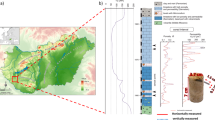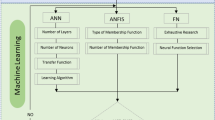Abstract
The carbonate reservoir has a number of properties such as multi-type pore space, strong heterogeneity, and complex pore structure, which make the classification of reservoir pore structure extremely difficult. According to nuclear magnetic resonance (NMR) T 2 spectrum characteristics of carbonate rock, an automatic pore structure classification and discrimination method based on the T 2 spectrum decomposition is proposed. The objective function is constructed based on the multi-variate Gaussian distribution properties of the NMR T 2 spectrum. The particle swarm optimization algorithm was used to solve the objective function and get the initial values and then the generalized reduced gradient algorithm was proposed for solving the objective function, which ensured the stability and convergence of the solution. Based on the featured parameters of the Gaussian function such as normalized weights, spectrum peaks and standard deviations, the combinatory spectrum parameters (by multiplying peak value and normalized weight for every peak) are constructed. According to the principle of fuzzy clustering, the carbonate rock pore structure is classified automatically and the discrimination function of each pore structure type is obtained using Fisher discrimination analysis. The classification results were analyzed with the corresponding casting thin section and scanning electron microscopy. The study shows that the type of the pore structure based on the NMR T 2 spectrum decomposition is strongly consistent with other methods, which provides a good basis for the quantitative characterization of the carbonate rock reservoir pore space and lays a foundation of the carbonate rock reservoir classification based on NMR logging.





Similar content being viewed by others
References
G.-P. Bai, J. Palaeogeogr. 8(2), 241–250 (2006) (in Chinese)
Y. Fan, X. Ge, H. Wang, S. Deng, J. Southwest Pet. Univ. (Science & Technology Edition) 32(3):6–10 (2010) (in Chinese)
R.A. Fisher, Ann. Eugen. 7, 179–188 (1936)
H. Westphal, I. Surholt, C. Kiesl, H.F. Them, T. Kruspe, Pure. Appl. Geophys. 162(3), 549–570 (2005)
J.C. Bezdek, R. Ehrlich, W. Full, Comput. Geosci. 10(2–3), 191–203 (1984)
J. Kennedy, R. Eberhart, Proceedings of IEEE International Conference on Neural Networks, 1995, pp. 1942–1948
D. Lang, C. Lv, Z. Lun, G. Shang, W. Pan, CT Theory Appl. 21(1), 27–35 (2012) (in Chinese)
J. Li, C. Zhang, X. Tang, J. Jianghan Pet. Inst. 26(1), 48–50 (2004) (in Chinese)
Z. Li, Y. Fan, S. Deng, H. Chen, Chin. J. Comput. Phys. 27(1), 115–120 (2010) (in Chinese)
H. Liu, Q. Zhu, Z. Zhou, Prog. Explor. Geophys. 28(6), 425–427 (2005) (in Chinese)
L.S. Lasdon, A.D. Waren, A. Jain, M. Ratner, ACM Tran. Math. Softw. 4, 34–50 (1978)
N. Rohilla, Dr. G.J. Hirasaki, in Proceedings of the International Symposium of the Society of Core Analysts, Austin, Texas, USA, 18–21 September 2011, SCA2011-21, pp. 1–12
M. Tan, W. Zhao, Progr. Geophys. 21(2), 489–493 (2006) (in Chinese)
S. Valliappan, V. Tandjiria, N. Khalili, Int. J. Numer. Anal. Meth. Geomech. 23(10), 1043–1065 (1999)
Z.D. Wang, L.Z. Xiao, T.Y. Liu, Sci. Chin. (G) 33((4), 323–332 (2003) (in Chinese)
Q. Yan, H. Zhao, L. Sima, Z. Shi, Nat. Gas Ind. 30(1), 36–38 (2010) (in Chinese)
Y. Yang, J. Qin, C. Di, L. Liu, Z. Fan, J. Gun Lanuch Control 33(4), 17–20 (2011) (in Chinese)
O. Yeniay, Math. Probl. Eng. 2, 165–173 (2005)
Acknowledgments
The work was financially supported by the Fundamental Research Funds for the Central Universities (no. 11CX06001A), National Science and Technology major Project of China (no. 2011ZX05020-008), Science and Technology Major Project of CNPC (no. 2011D_4101).We also thank graduate student Zeng Xing’s help in this paper.
Author information
Authors and Affiliations
Corresponding author
Rights and permissions
About this article
Cite this article
Ge, X., Fan, Y., Cao, Y. et al. Reservoir Pore Structure Classification Technology of Carbonate Rock Based on NMR T 2 Spectrum Decomposition. Appl Magn Reson 45, 155–167 (2014). https://doi.org/10.1007/s00723-013-0511-5
Received:
Revised:
Published:
Issue Date:
DOI: https://doi.org/10.1007/s00723-013-0511-5




